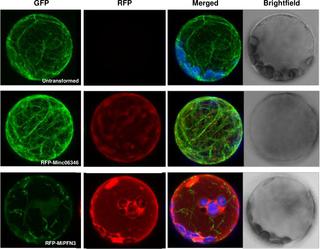PLoS Pathogens ( IF 5.5 ) Pub Date : 2018-03-15 , DOI: 10.1371/journal.ppat.1006947 Natthanon Leelarasamee , Lei Zhang , Cynthia Gleason

|
Root-knot nematodes secrete effectors that manipulate their host plant cells so that the nematode can successfully establish feeding sites and complete its lifecycle. The root-knot nematode feeding structures, their “giant cells,” undergo extensive cytoskeletal remodeling. Previous cytological studies have shown the cytoplasmic actin within the feeding sites looks diffuse. In an effort to study root-knot nematode effectors that are involved in giant cell organogenesis, we have identified a nematode effector called MiPFN3 (Meloidogyne incognita Profilin 3). MiPFN3 is transcriptionally up-regulated in the juvenile stage of the nematode. In situ hybridization experiments showed that MiPFN3 transcribed in the nematode subventral glands, where it can be secreted by the nematode stylet into the plant. Moreover, Arabidopsis plants that heterologously expressed MiPFN3 were more susceptible to root-knot nematodes, indicating that MiPFN3 promotes nematode parasitism. Since profilin proteins can bind and sequester actin monomers, we investigated the function of MiPFN3 in relation to actin. Our results show that MiPFN3 suppressed the aberrant plant growth phenotype caused by the misexpression of reproductive actin (AtACT1) in transgenic plants. In addition, it disrupted actin polymerization in an in vitro assay, and it reduced the filamentous actin network when expressed in Arabidopsis protoplasts. Over a decade ago, cytological studies showed that the cytoplasmic actin within nematode giant cells looked fragmented. Here we provide the first evidence that the nematode is secreting an effector that has significant, direct effects on the plant’s actin cytoskeleton.
中文翻译:

根结线虫效应子MiPFN3破坏植物肌动蛋白丝并促进寄生
根结线虫会分泌操纵其宿主植物细胞的效应子,从而使线虫能够成功地建立觅食位点并完成其生命周期。根结线虫的进食结构,即它们的“巨细胞”,经历了广泛的细胞骨架重塑。先前的细胞学研究表明,饲喂部位的细胞质肌动蛋白看起来很弥散。为了研究与巨细胞器官发生有关的根结线虫效应子,我们鉴定了一种名为MiPFN3(Meloidogyne incognita Profilin 3)的线虫效应子。MiPFN3在线虫的幼年期转录上调。原位杂交实验表明,MiPFN3转录在线虫腹膜下腺中,在那里它可以被线虫管心针分泌到植物中。此外,异源表达MiPFN3的拟南芥植物更容易受到根结线虫的侵害,表明MiPFN3促进了线虫寄生。由于profilin蛋白可以结合并隔离肌动蛋白单体,因此我们研究了MiPFN3与肌动蛋白有关的功能。我们的结果表明,MiPFN3抑制了转基因植物中生殖肌动蛋白(AtACT1)的错误表达引起的异常植物生长表型。此外,它在体外破坏肌动蛋白的聚合检测,并减少了拟南芥原生质体中表达时的丝状肌动蛋白网络。十多年前,细胞学研究表明,线虫巨细胞内的细胞质肌动蛋白看起来是碎片化的。在这里,我们提供了第一个证据,表明线虫正在分泌一种对植物的肌动蛋白细胞骨架具有重要直接影响的效应子。











































 京公网安备 11010802027423号
京公网安备 11010802027423号